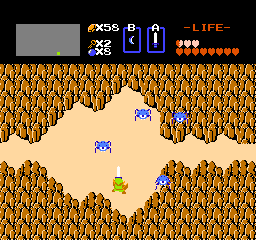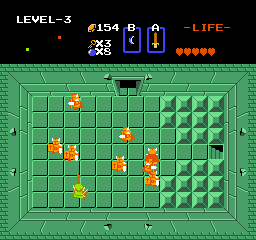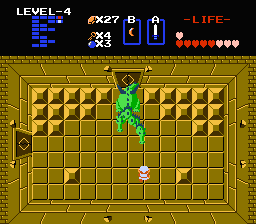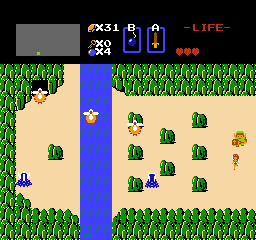
It has been thirty years since the game in the golden cartridge impacted our hobby forever.
It kicked off one of gaming’s legendary franchises, and is still remembered as one of the best titles ever released for the Nintendo Entertainment System. It held adventure, danger, and for the brave, it held triumph. The Legend of Zelda, released on February 21st, 1986, set new standards in quality and embedded itself into pop culture (and our memories) in a way few games could.

The game was developed by Nintendo R&D 4, headed by Shigeru Miyamoto and Takashi Tezuka (both under pseudonyms). This was the same R&D team (for the most part) that had developed Super Mario Brothers. The focus for Legend of Zelda‘s development was to produce a game very much unlike SMB, a game where things did not progress in a straight line… more of an adventure experience. As a matter of fact, the two games were developed (mostly) simultaneously, with the team deciding which concepts were “Zelda ideas” and which were better for Mario. Much of this decision-making and concept-shaping fell to Miyamoto, with Tezuka writing the storyline for the game. Miyamoto has said that the game was inspired by his childhood wanderings in the countryside near Kyoto, and that the game’s titular princess was named after the wife of author F. Scott Fitzgerald.
According to the manual, our story begins when Link stumbles upon a nursemaid named Impa, who is being attacked by monsters. Link drives them off, rescuing the old maid. She tells him of her mistress, Princess Zelda of Hyrule, and how Ganon (sometimes spelled Gannon) has gone to war with Hyrule to gain the Triforce of Wisdom, capturing Zelda in the process. Ganon already has the Triforce of Power, but Zelda managed to scatter the Triforce of Wisdom into 8 pieces and hide it from the monstrous dark lord before he imprisoned her. The princess told Impa to find someone brave enough to reassemble the pieces and use the Wisdom Triforce to defeat Ganon. Needless to say, Impa is pretty convinced she has her man.

Now, how Link managed to drive off monsters without even a sword is beyond me, since you start the game without it and can’t really do jack shit until you go get it. Thankfully, it’s in the very first cave you see.

Now it’s time to get to it! But… where do we go? Well, that was supposed to be part of the fun, according to the developers. Legend of Zelda is supposed to be unlike a typical video game of the time; players were encouraged not only to wander, but to communicate with one another when not playing, and share ideas or discoveries. Exploration also lent the game significant play time compared to a platformer, which many players will master and then only sparingly play again. To find the eight parts of the Triforce, you must wander about and find the dungeons they are hidden in. While there is a loose order to this quest, there is nothing stopping the player from making his or her own way and discovering this without being railroaded. Link must not only find the Triforce, but also must uncover certain items in these dungeons and elsewhere. Some of these are merely useful tools (like the boomerang), and some of them are necessary to bypass certain obstacles or discover new places in order to continue progress (such as the flute and the raft). In a way, the game itself is an intricate puzzle… far more intricate than was the norm in 1986.

This isn’t to say you’ll miss out on some intense fighting. In fact, Ganon’s amassed an army of horrible monsters to stop you. The list defies full cataloging within the scope of this article, but the foes you’ll face range from skeletons to snakes to armored men to ghosts to teleporting wizards and more. Many times (especially in dungeons) you can kill one monster, meant to be the leader of the mob, and all of them will disappear. Other times, you simply have to slog through everyone. Thankfully, there are two more powerful swords to find, as well as a bow and arrows, a magic wand, and bombs. It is a good general practice to keep your bombs well stocked. They not only come in handy for murder (and are the only way to hurt one of the bosses), but they can also blow holes in certain walls, which will become necessary later in the game. Once you’ve assembled the Triforce, gotten all the upgrades money and sweat can buy, and located Ganon’s well-hidden lair, you must venture into it and slay him. Ganon is no spring bitch. He is strapped and ready to party in the worst way possible.






Hyrule is a pretty brutal place… but Link is one tough little dude.
Oh, you say you’ve done all that? You’ve beaten the game? Well, turns out you can play it over again, with everything shuffled around and much more challenging. Good luck! You can also do this by naming your character “ZELDA” in the creation screen. This “2nd quest” is worth boasting about if you’ve conquered it. It was also novel for its time, or at least wasn’t a common feature in home video gaming. More replay value? You betcha. Hell, it pretty much comes with its own sequel this way!

Speaking of sequels… Legend of Zelda spawned one of Nintendo’s best known and most successful franchises to date, the first sequel being the mostly side-scrolling Zelda II: Adventures of Link. Since then, pretty much every Nintendo console or platform has received at least one installment in the series. The SNES’s Link to the Past is a notable entry in the saga, and later systems saw more Zelda goodness in the form of games like Ocarina of Time, Wind Waker, and Majora’s Mask. Each new game added new depth to gameplay, while preserving the original idea of an adventure game that encourages real exploration.
Legend of Zelda sold over 6.5 million copies, making it one of the best selling console games of all time. Any retro gamer can remember their first adventure in Hyrule… the glory, the danger, and the triumph. How it felt to be a hero. Thirty years later, that glory has not gone stale. It still glitters as golden as the cartridge we all slipped into our NES only to hear the theme that still gives me chills:
Happy 30th birthday, Link. I guess you really have come of age.




